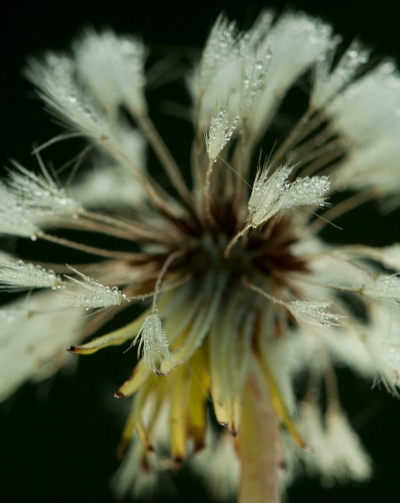Study Offers Clues to How Plants Evolved to Cope with Cold
Many plants were well equipped for icy climates even before cold conditions hit
22 December 2013

|
|
Frost covers a dandelion seed head. Plants have evolved in ways that help them deal with cold conditions.
Credit: Simon Uribe-Convers |
Knoxville, TN - Researchers have found new clues to how plants evolved to withstand wintry weather. In a study, which appears in the December 22 issue of the journal Nature, the team constructed an evolutionary tree of more than 32,000 species of flowering plants - the largest time-scaled evolutionary tree to date. The researchers then combined their evolutionary tree with freezing exposure records and leaf and stem data for thousands of species. In so doing, they were able to reconstruct how plants evolved to cope with cold as they spread across the globe.
Fossil evidence and reconstructions of past climatic conditions suggest that early flowering plants lived in warm tropical environments, explained co-author Jeremy Beaulieu, a postdoctoral fellow at the National Institute for Mathematical and Biological Synthesis (NIMBioS) at the University of Tennessee, Knoxville.
As plants spread to higher latitudes and elevations, they evolved in ways that helped them deal with cold conditions. Plants that live in the tundra, such as Arctic cinquefoil and three-toothed saxifrage, can withstand winter temperatures below minus 15 degrees Celsius.
Unlike animals, most plants can't move to escape the cold or generate heat to keep them warm. It's not so much the cold but the ice that poses problems for plants. For example, freezing and thawing creates air bubbles in plants' internal water transport systems, which can block the flow of water from the roots to the leaves killing the plant.
The researchers identified three traits that help plants get around these problems:
- Some plants, such as hickories and oaks, avoid freezing damage by dropping their leaves before the winter chill sets in - effectively shutting off the flow of water between roots and leaves - and growing new leaves and water transport cells when warmer weather returns.
- Other plants, such as birches and poplars, also protect themselves by having narrower water transport cells, which makes the parts of the plant that deliver water less susceptible to blockage during freezing and thawing.
- Others die back to the ground in winter and re-sprout from their roots or start growing as new plants from seeds when conditions are right.
To compile the plant trait data for their study, the researchers spent hundreds of hours scouring and merging multiple large plant databases containing tens of thousands of species, largely with the support of the National Evolutionary Synthesis Center in North Carolina and Macquarie University in Australia.
When they mapped their collected leaf and stem data onto their evolutionary tree for flowering plants, they found that many plants were well equipped for icy climates even before cold conditions hit.
Plants that die back to the ground in winter, for example, acquired the ability to die and come back when conditions improve long before they first experienced freezing. Similarly, species with narrow water transport cells acquired a finer circulatory system well before they confronted cold climates.
"This suggests that some other environmental pressure – possibly drought - caused these plants to evolve this way, and it happened to work really well for freezing tolerance too," said co-author Amy Zanne at the George Washington University.
The only exceptions were plants that shed and replace their leaves seasonally - these plant groups didn't gain the ability to drop their leaves during winter until after they encountered freezing, Beaulieu added.
As a next step, the researchers plan to use their evolutionary tree to find out how plants evolved to withstand other environmental stresses in addition to freezing, such as drought and heat.
Also co-authoring the study was Brian O'Meara, a member of NIMBioS' Affiliate Faculty and assistant professor in UT's Department of Ecology and Evolutionary Biology.
The tree, data and source code are freely available online in the Dryad digital repository at http://dx.doi.org/10.5061/dryad.63q27 and in the TRY plant trait database at http://www.try-db.org. You can also explore the tree at http://www.onezoom.org/vascularplants_tank2013nature.htm.
Citation: Zanne, A. et al. 2013. Three keys to the radiation of angiosperms into freezing environments. Nature. [Online]
Media Coverage Highlights
Guardian Express: Plant evolution study shows how some plants prevent freezing.
Business Standard: Largest evolutionary tree of flowering plants mapped.
International Science Times: These three coping mechanisms help deal with cold weather.
Nature World News: Study finds how flowering plants cope with the cold
#
The National Institute for Mathematical and Biological Synthesis (NIMBioS) brings together researchers from around the world to collaborate across disciplinary boundaries to investigate solutions to basic and applied problems in the life sciences. NIMBioS is supported by the National Science Foundation, the U.S. Department of Homeland Security, and the U.S. Department of Agriculture with additional support from The University of Tennessee, Knoxville.
CONTACT:
Catherine Crawley, NIMBioS - (865) 974-9350 ccrawley@nimbios.org
NIMBioS
1122 Volunteer Blvd., Suite 106
University of Tennessee
Knoxville,
TN 37996-3410
PH: (865) 974-9334
FAX: (865) 974-9461
Contact NIMBioS


